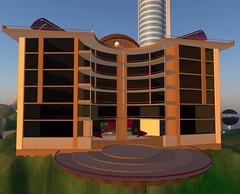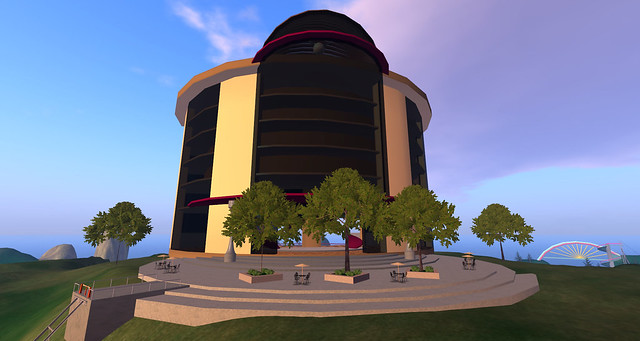The hospitality industry is responsible for getting myself and Ener Hax into virtual worlds. In the media frenzied coverage of Second Life in 2006, two hospitality giants received a fair share of coverage and worked that to their advantage.
Starwood had the Virtual aloft built as an architectural feedback project and International Hotel Group (IHG) had Crowne Plaza branded meeting rooms. Some of my video work featured those Crowne Plaza meetings rooms which were bookable via an online engine, just like much of their function space is.
Both of those are now gone. The aloft had an exit plan which included donating their island to a worthy endeavor – Global Kids. Crowne Plaza stayed longer but quietly closed at some point last year.
 Second Life was an exciting new technology with so much media coverage that it was hard to ignore. Couple that with the promise of virtual meetings sweeping the globe and it was natural for the hopsitality industry to explore it. Linden Lab, the creators of Second Life, touted an end to face-to-face meetings with IBM case studies (IBM poured 12 million into virtual worlds in 2006-07).
Second Life was an exciting new technology with so much media coverage that it was hard to ignore. Couple that with the promise of virtual meetings sweeping the globe and it was natural for the hopsitality industry to explore it. Linden Lab, the creators of Second Life, touted an end to face-to-face meetings with IBM case studies (IBM poured 12 million into virtual worlds in 2006-07).
Fortunately for the hospitality sector, there will always be a need for “real” meetings and, at best, virtual worlds could supplement those and be used as an upsell item. Certainly some small meetings could be, and are, done with virtual worlds, but they should not be viewed as a threat.
Meeting Planners International has explored virtual worlds and there is an opportunity for properties to be the source for virtual meeting space no differently than real function space. Virtual events have similar needs as real events and do generate real revenue (Dan Parks’ Virtualis, complete with MPI certified professionals, attests to this).
Up until last year, Second Life was about the only viable choice for this and had many issues that led to users, such as IHG, ending their virtual presence. Some of these factors include cost ($295+ per month), being part of a larger “world” and the potential lack of privacy, not truly owning your virtual assets, and being subject to a third party’s terms of service. Another factor may also the stigma that has been associated with Second Life being viewed as a game or world full of sex-craved avatars.
In the last year a viable alternative has quietly been growing. Its adoption is primarily by educators and business users who recognized the power of Second Life but did not want any of its limits. OpenSim is an open source virtual world server side application that uses the Second Life viewer (or third party Second Life viewers). While the platform is not Second Life, it does look, and act, like Second Life due to the viewer (the client side).
Freedom from high cost results from OpenSim being an open source software which can be installed on your own servers (in fact it can even be installed on a USB drive, making for some interesting possibilities for meeting planners to show room setups to clients). Being able to host this application yourself means it can be fully under your control and security.
OpenSim may be poised to be reevaluated by the hospitality industry and has matured to the point of opening achievable opportunities in this sector. From offering virtual space as an upsell for a real event to being used in the visualization of function room setups, virtual worlds seem to now be here to stay and be adopted steadily according to Gartner.

reposted on iliveisl
